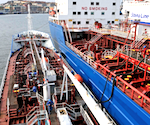European Ports Towards Better LNG Bunkering Infrastructure

North European ports are leading a switch to natural gas as a cleaner way to power ships than burning oil-based bunker fuel, while regulation and cost benefits are likely to convince other sectors to follow in coming years. Gas has been used so far mostly for power generation and heating, while oil products have dominated the transport sector. The outlook for cheaper gas in the wake of the shale gas boom in North America as well as toughening environmental regulation in Europe have driven up investment in gas as a transport fuel. Ports in northern Europe, pushed by regulation to clean up a major source of pollution, are now at the forefront with the planned installation of liquefied natural gas (LNG) fuel stations for ships, known as bunkering, before the end of the decade.
“At present there are around 20 vessels in operation using LNG as a marine fuel; almost all are in Scandinavia. Many more are on order, and even more will be likely to be ordered,” said Andrew Clifton, general manager of the Society of International Gas Tanker and Terminal Operators. “It will be at least two years before major deep-sea shipping companies order LNG-powered engines once financing becomes more available,” said Arthur Barret, director of LNG bunkering at French group Gaztransport & Technigaz. “By then, hopefully, there will also be more infrastructure to load LNG as a ship fuel,” he added.
A European Union draft law has set a goal to cut greenhouse gas emissions from the shipping sector by at least 40 percent by 2050 from 2005 levels. The European Commission is pushing for regulation that will oblige all major ports in the EU to provide LNG refuelling facilities by 2020. “There seems to be a very strong economic argument in favour of supporting LNG in shipping,” a European Commission working document published in January said. Swedish infrastructure company Swedegas and Dutch oil and gas storage company Vopak are jointly investing around 1 billion Swedish crowns (USD 155.3 million) in an LNG terminal at the port of Gothenburg, Sweden’s biggest. Swedegas said it was also looking to fit other Swedish ports with LNG stations. “We can start bunkering in Gothenburg in 2015, and activity will be expanded by 2017,” a spokeswoman for Swedegas said. The Belgian port of Antwerp, one of Europe’s biggest, is chairing an international working group with other leading ports, including Amsterdam, Bremerhaven, Brunsbuttel, Gothenburg, Hamburg, Le Havre, Los Angeles, Long Beach, Rotterdam, Stockholm and Zeebrugge, to develop guidelines on safe procedures for LNG bunkering operations. Rotterdam and Singapore, both major transport hubs, have already announced plans to invest in facilities that would allow ships to take LNG as a marine fuel, and Norway has already developed a state-driven national LNG marine transport fuel storage network.
Source: Reuters






